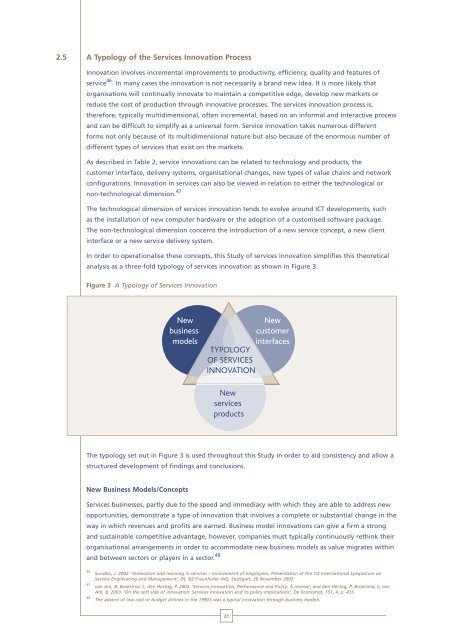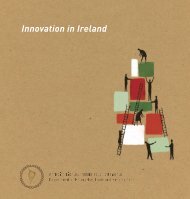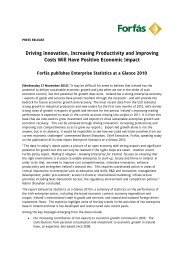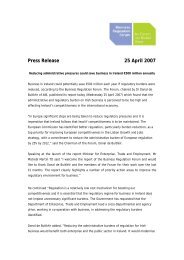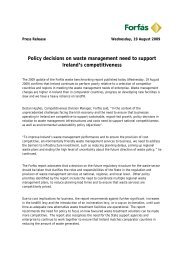Services Innovation in Ireland - Options for ... - Europe INNOVA
Services Innovation in Ireland - Options for ... - Europe INNOVA
Services Innovation in Ireland - Options for ... - Europe INNOVA
You also want an ePaper? Increase the reach of your titles
YUMPU automatically turns print PDFs into web optimized ePapers that Google loves.
2.5 A Typology of the <strong>Services</strong> <strong>Innovation</strong> Process<br />
<strong>Innovation</strong> <strong>in</strong>volves <strong>in</strong>cremental improvements to productivity, efficiency, quality and features of<br />
service 46 . In many cases the <strong>in</strong>novation is not necessarily a brand new idea. It is more likely that<br />
organisations will cont<strong>in</strong>ually <strong>in</strong>novate to ma<strong>in</strong>ta<strong>in</strong> a competitive edge, develop new markets or<br />
reduce the cost of production through <strong>in</strong>novative processes. The services <strong>in</strong>novation process is,<br />
there<strong>for</strong>e, typically multidimensional, often <strong>in</strong>cremental, based on an <strong>in</strong><strong>for</strong>mal and <strong>in</strong>teractive process<br />
and can be difficult to simplify as a universal <strong>for</strong>m. Service <strong>in</strong>novation takes numerous different<br />
<strong>for</strong>ms not only because of its multidimensional nature but also because of the enormous number of<br />
different types of services that exist on the markets.<br />
As described <strong>in</strong> Table 2, service <strong>in</strong>novations can be related to technology and products, the<br />
customer <strong>in</strong>terface, delivery systems, organisational changes, new types of value cha<strong>in</strong>s and network<br />
configurations. <strong>Innovation</strong> <strong>in</strong> services can also be viewed <strong>in</strong> relation to either the technological or<br />
non-technological dimension. 47<br />
The technological dimension of services <strong>in</strong>novation tends to evolve around ICT developments, such<br />
as the <strong>in</strong>stallation of new computer hardware or the adoption of a customised software package.<br />
The non-technological dimension concerns the <strong>in</strong>troduction of a new service concept, a new client<br />
<strong>in</strong>terface or a new service delivery system.<br />
In order to operationalise these concepts, this Study of services <strong>in</strong>novation simplifies this theoretical<br />
analysis as a three-fold typology of services <strong>in</strong>novation as shown <strong>in</strong> Figure 3.<br />
Figure 3 A Typology of <strong>Services</strong> <strong>Innovation</strong><br />
New<br />
bus<strong>in</strong>ess<br />
models<br />
The typology set out <strong>in</strong> Figure 3 is used throughout this Study <strong>in</strong> order to aid consistency and allow a<br />
structured development of f<strong>in</strong>d<strong>in</strong>gs and conclusions.<br />
New Bus<strong>in</strong>ess Models/Concepts<br />
New<br />
customer<br />
<strong>in</strong>terfaces<br />
TYPOLOGY<br />
OF SERVICES<br />
<strong>INNOVA</strong>TION<br />
New<br />
services<br />
products<br />
<strong>Services</strong> bus<strong>in</strong>esses, partly due to the speed and immediacy with which they are able to address new<br />
opportunities, demonstrate a type of <strong>in</strong>novation that <strong>in</strong>volves a complete or substantial change <strong>in</strong> the<br />
way <strong>in</strong> which revenues and profits are earned. Bus<strong>in</strong>ess model <strong>in</strong>novations can give a firm a strong<br />
and susta<strong>in</strong>able competitive advantage, however, companies must typically cont<strong>in</strong>uously reth<strong>in</strong>k their<br />
organisational arrangements <strong>in</strong> order to accommodate new bus<strong>in</strong>ess models as value migrates with<strong>in</strong><br />
and between sectors or players <strong>in</strong> a sector. 48<br />
46 Sundbo, J. 2002. ‘<strong>Innovation</strong> and learn<strong>in</strong>g <strong>in</strong> services – Involvement of employees, Presentation at the 1st International Symposium on<br />
Service Eng<strong>in</strong>eer<strong>in</strong>g and Management’, DL ’02 Fraunhofer IAO, Stuttgart, 26 November 2002.<br />
47 van Ark, B; Broersma, L; den Hertog, P. 2003. ‘<strong>Services</strong> <strong>Innovation</strong>, Per<strong>for</strong>mance and Policy: A review’; and den Hertog, P; Broersma, L; van<br />
Ark, B. 2003. ‘On the soft side of <strong>in</strong>novation: <strong>Services</strong> <strong>in</strong>novation and its policy implications’, De Economist, 151, 4, p. 433.<br />
48 The advent of low cost or budget airl<strong>in</strong>es <strong>in</strong> the 1990’s was a typical <strong>in</strong>novation through bus<strong>in</strong>ess models.<br />
21


